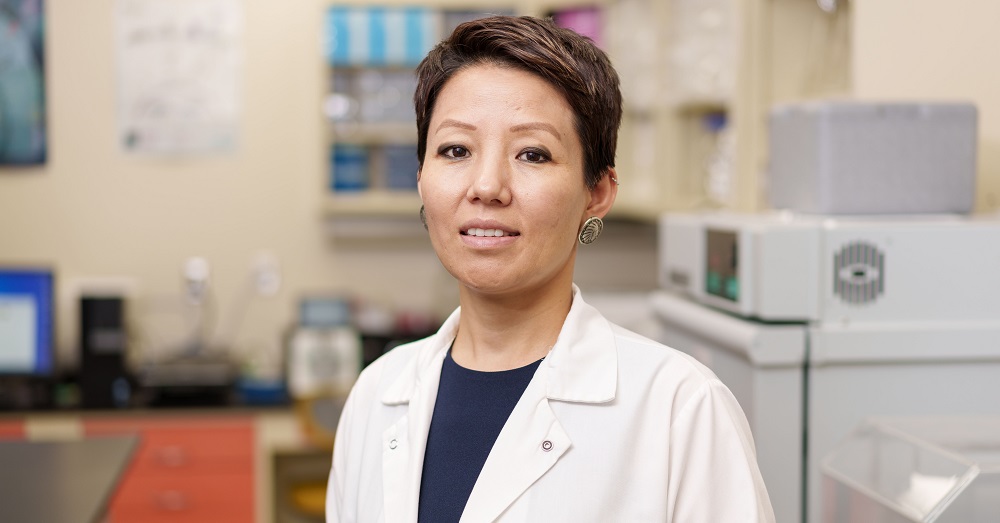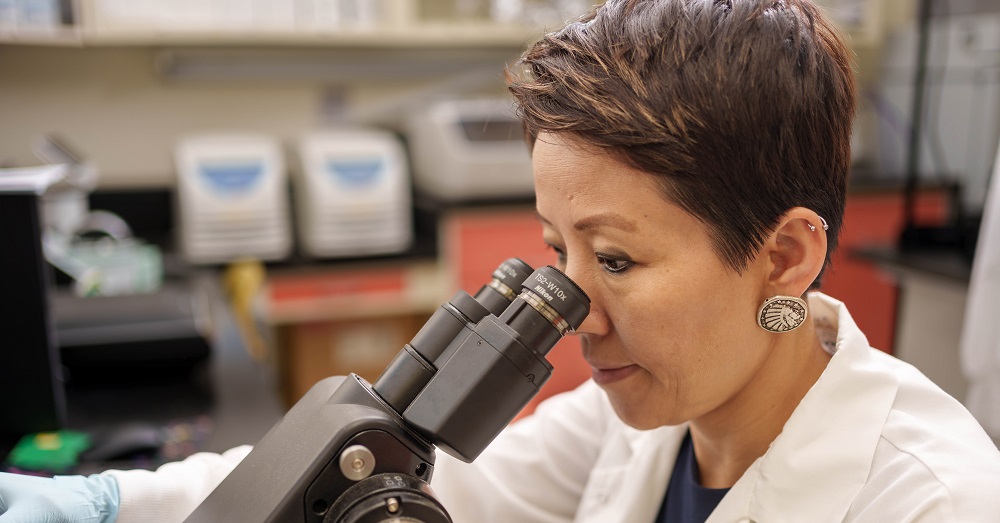NIH Grant to Aid TTUHSC’s Bhutia in Quest to Treat Pancreatic Cancer

With a survival rate in the single digits, pancreatic ductal adenocarcinoma (PDAC) is highly lethal. In fact, by the time PDAC is clinically diagnosed, it is already considered incurable via surgery or other means in up to 90% of patients.
Yangzom D. Bhutia, D.V.M., Ph.D., from the Department of Cell Biology and Biochemistry at the Texas Tech University Health Sciences Center (TTUHSC) School of Medicine, has for years focused her research on PDAC. To bolster her efforts, the National Cancer Institute at the National Institutes of Health recently awarded Bhutia a five-year, $1.76 million grant (“SLC6A14 as a unique drug target to treat pancreatic cancer”) to investigate potential novel treatments for this often-silent killer.
“With this grant, we will focus on the amino acid transporter known as SLC6A14, also known as ATB0,+, and its relevance to PDAC,” Bhutia said. “SLC6A14 is significantly upregulated in PDAC and therefore we want to use it as a drug target to potentially treat pancreatic cancer. I also would like to specifically thank Dr. Patrick Reynolds, director of the TTUHSC School of Medicine Cancer Center, for giving me an opportunity to be a part of the CPRIT-TREC (Cancer Prevention and Research Institute of Texas - Texas Regional Excellence in Cancer) grant. This grant was highly instrumental in furthering my research in SLC6A14 and pancreatic cancer, which ultimately led to its fruition.”
Because SLC6A14 is an amino acid transporter, blocking it makes the cancer cells amino acid-deprived and causes those cells to eventually die. However, cancer cells are smart, and to bypass this unfavorable situation created by the SLC6A14 blockade, they upregulate compensatory nutrient scavenging mechanisms known as autophagy and macropinocytosis.
Autophagy is a process that allows cells to discard from their cytoplasm any old,
damaged or abnormal proteins and other substances in an orderly manner. Likewise,
macropinocytosis allows the cells to uptake materials such as nutrients and other
molecules, but from the extracellular fluid in a non-specific manner. Bhutia said
the induction of autophagy and macropinocytosis by the cancer cells in response to
SLC6A14 blockade can partly compensate for the loss of SLC6A14. This means the full
potential of SLC6A14 inactivation is not being realized, which is good for the cancer
cells, but not for the patient.
“Because we are unable to see the full potential of SLC6A14 inactivation, our idea
here is to simultaneously target both SLC6A14 as well as autophagy and macropinocytosis,”
Bhutia explained.
To test that, Bhutia’s laboratory will use alpha-methyl-L-tryptophan (a-MLT) to block SLC6A14, and hydroxychloroquine (HCQ) to inhibit autophagy and macropinocytosis. a-MLT is a known blocker of SLC6A14. Likewise, HCQ is approved by the U.S. Food and Drug Administration (FDA) as a drug used to treat or prevent malaria. Literature suggests that HCQ inhibits both autophagy and macropinocytosis.
“So, by using this strategy of simultaneously blocking SLC6A14 as well as inhibiting the compensatory mechanisms of nutrient acquisition (autophagy and macropinocytosis), is it possible to get 100% efficacy?” Bhutia asked. “That's the entire idea behind this grant.”

In past studies, Bhutia has used PDAC cell lines, patient derived xenografts (PDXs) samples and in vivo mouse transplantation models to investigate certain aspects of PDAC and SLC6A14. For this grant, she will extrapolate data collected during that previous research and apply it to what is known as the KPC, or the spontaneous mouse model of PDAC. Here, K denotes the KRAS gene that provides the blueprint for producing K-Ras protein. This protein acts as a molecular switch for the growth and proliferation of cells. Likewise, P represents gene p53, also known as the “guardian of the genome,” which encodes for the p53 protein. It has a tumor suppressor function and, when under cellular stress, p53 regulates gene expression to control DNA repair, cell division and cell death.
“In this mouse model, the KRAS and the p53 is mutated, and when bred with PDX-Cre transgenic mice, the mutant KRAS and p53 is specifically activated in the pancreas leading to the spontaneous development of PDAC. These mice develop full blown PDAC in about three to five months, fully recapitulating the disease seen in the human patients,” Bhutia said. “The question is: can you see better survival in this mouse model, or can you delay the progression of the pancreatic intraepithelial neoplasia, i.e., the preneoplastic lesions or delay the development of pancreatic cancer?”
To answer that question, Bhutia’s laboratory will use both pharmacological intervention, wherein the KPC mice will be treated with a-MLT to block Slc6a14 (lowercased as a mouse transporter; uppercase denotes the human variant), and genetic deletion, wherein the KPC mice will be bred with Slc6a14 knockout mice.
“That is one area that we are looking at,” Bhutia said. “The other aspect is to characterize the induction of autophagy and macropinocytosis and to test whether combination therapy using a-MLT and HCQ will lead to a better therapeutic outcome as opposed to monotherapy in PDAC. To test this, we will use human PDAC cell lines, as well as orthotopic implantation mouse models (injecting or transplanting tumor cells or tumor tissue into anatomically appropriate sites), and test whether or not a two-drug combination (a-MLT/HCQ) that simultaneously targets SLC6A14 (a-MLT) and autophagy and macropinocytosis (HCQ) will have a synergistic/additive effect in the growth inhibition of PDAC.”
Bhutia emphasized that PDAC is a devastating disease with very low survival rates.
“Therefore the identification of any new therapeutic targets or new therapies will greatly benefit patients suffering from this lethal form of cancer,” Bhutia added. “Moreover, if successful, a-MLT and HCQ can be easily transitioned into clinics to treat PDAC patients with upregulated SLC6A14 since both drugs are FDA-approved.”
